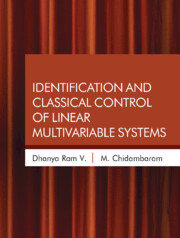Book contents
- Frontmatter
- Contents
- Preface
- Acknowledgements
- List of Abbreviations
- Notations
- 1 Models, Control Theory, and Examples
- 2 Identification and Control of SISO Systems
- 3 Introduction to Linear Multivariable Systems
- 4 CRC Method for Identifying TITO Systems
- 5 CRC Method for Identifying SISO Systems by CSOPTD Models
- 6 CRC Method for Identifying TITO Systems by CSOPTD Models
- 7 Identification of StableMIMO System by Optimization Method
- 8 Identification of Centralized ControlledMultivariable Systems
- 9 Identification of Multivariable SOPTD Models by Optimization Method
- 10 Identification of Unstable TITO Systems by Optimization Technique
- 11 Centralized PI Controllers Based on Steady State Gain Matrix
- 12 SSGM Identification and Control of Unstable Multivariable Systems
- 13 Control of Stable Non-square MIMO Systems
- 14 Control of Unstable Non-square Systems
- 15 Trends in Control ofMultivariable Systems
- Appendix A Identification of Unstable Second Order Transfer Function Model with a Zero by Optimization Method
- Appendix B For Chapter 3
- Appendix C For Chapter 7
- Bibliography
- Index
Appendix B - For Chapter 3
Published online by Cambridge University Press: 31 July 2022
- Frontmatter
- Contents
- Preface
- Acknowledgements
- List of Abbreviations
- Notations
- 1 Models, Control Theory, and Examples
- 2 Identification and Control of SISO Systems
- 3 Introduction to Linear Multivariable Systems
- 4 CRC Method for Identifying TITO Systems
- 5 CRC Method for Identifying SISO Systems by CSOPTD Models
- 6 CRC Method for Identifying TITO Systems by CSOPTD Models
- 7 Identification of StableMIMO System by Optimization Method
- 8 Identification of Centralized ControlledMultivariable Systems
- 9 Identification of Multivariable SOPTD Models by Optimization Method
- 10 Identification of Unstable TITO Systems by Optimization Technique
- 11 Centralized PI Controllers Based on Steady State Gain Matrix
- 12 SSGM Identification and Control of Unstable Multivariable Systems
- 13 Control of Stable Non-square MIMO Systems
- 14 Control of Unstable Non-square Systems
- 15 Trends in Control ofMultivariable Systems
- Appendix A Identification of Unstable Second Order Transfer Function Model with a Zero by Optimization Method
- Appendix B For Chapter 3
- Appendix C For Chapter 7
- Bibliography
- Index
Summary
Details of the Relay Auto-Tuning Method for TITO Systems
The method proposed by Palmor et al. (1995) concentrated on the identification of DCP (Desired Critical Point) along with the steady state gains. The usual method involves the open loop step or pulse response test. Palmor et al. (1995) recommend a closed loop method. The process output y(t) and manipulated variable u(t) are determined by two experiments conducted on the system with two different reference (that are not both 0 mean) signals along with the relays. The steady state gain of the system is then calculated as (Palmor et al., 1995):
where p1 and p2 (vectors) are calculated from the area under the corresponding waveform for one period duration in the responses and interactions in the output (Palmor et al., 1995). Similarly, q1 and q2 (vectors) are calculated from the area under the corresponding waveform for one period duration in themanipulated variables. GP (0) which is the SSGM of the system can be easily calculated as discussed in Chapter 11.
To identify DCP, relative importance is given to one loop over another using a weighting factor C, as given in Eq. (B.2).
K1c and K2,c are the critical gains of the controllers. Once the steady state gains and the resultant error amplitudes are known, the relay height ratio (h1 and h2) can be calculated as in Eq. (B.3).
Here a1 and a2 are the amplitude of output oscillations obtained and Cd indicates the desired quantity of C. None of these quantities in Eq. (B.3) is available initially to the auto tuner. The relay ratio may be calculated by a series of limit cycle experiments. The algorithm is repeated till the convergence criterion is satisfied |ϕ − ϕd| < ϵ. Once the optimum relay height is known, the DCP can be obtained by the relay feedback test.
From the Fourier series expansion, the amplitude of the relay response is assumed to be the result of the primary harmonic output. Therefore the ultimate gain can then be calculated (Yu, 2006; Astrom and Hagglund, 1995) from Eq. (B.4).
- Type
- Chapter
- Information
- Publisher: Cambridge University PressPrint publication year: 2023



